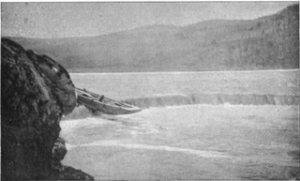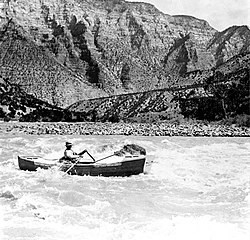
In November 1928, Glen & Bessie Hyde disappeared while on an expedition to run all the rapids on the Colorado River. They were never seen again. The newlyweds were engaged in a publicity stunt they hoped would earn them fame and fortune. Obscure fame they still have; fortune, not so much. In many ways, it was an ill-fated voyage from the start.
Bessie Louise Haley [Born Dec. 19, 1905 – Missing, presumed dead, Nov. 1928]
Bessie graduated from Parkersburg High School in Parkersburg, West Virginia, a small town located at the confluence of the Ohio and Little Kanawha Rivers, and began what was an adventurous life for the time. Some time after graduation, Bessie eloped with her high school sweetheart, Earl Hemlock. The marriage didn’t stick. During later divorce proceedings, Bessie said her husband was indifferent and “didn’t seem to care.”
When Bessie asked Earl for a divorce, he refused her request. During the 1920s, divorce was still a rare event, particularly in a small town. Bessie moved to San Francisco to start a new life.
Glen Rollins Hyde [Born Dec. 9, 1898 – Missing, presumed dead, Nov. 1928]

Glen was a farmer from Twin Falls, Idaho. I didn’t find much information about him. However, while growing up, Glen and his family ran the rapids in the Snake River in Idaho and the Peace River in Canada. Glen was also familiar with a boat known as a scow, which is more like a flat bottomed barge than a boat. The vessels do well in shallow water. The name scow derives from the Dutch word schouw.
Courtship & Marriage
In 1927, Bessie decided to take a passenger ship from San Francisco to Los Angeles. While at sea, she met Glen, and fell in love with the handsome adventurer. Bessie wrote her husband, and asked for a divorce. He refused.
So Bessie did what more and more unhappy wives were doing. She went to Elko, Nevada, lived there for six months to qualify as a Nevada resident, and divorced Earl.
On April 10, 1928, Bessie and Glen married. She was 23 years old; he was 30.

The Fateful Honeymoon Adventure
Glen had an unusual idea for a honeymoon. He and Bessie would build a scow and run the rapids from Green River, Utah through the Colorado River rapids in the Grand Canyon, and conclude their expedition in Needles, California. Today, you can drive between the two cities in seven hours and 15 minutes. In 1928, it took a bit longer to travel on the Colorado River. In fact, no one had ever done it.
Glen expected he and Bessie would succeed and ride the publicity trail of other popular heros like Amelia Earhart and Charles Lindbergh. Bessie would be the only woman ever to make the trip, and Glen one of the few men.

With the help of experts, Glen built the 20-foot scow he called Rain-in-the-Face in two days.
The couple set off down the canyons of the Green and Colorado Rivers on Oct. 20, and expected to reach Needles, California on December 6, about three weeks from the start of their journey. Initially, they made good time, traveling about 10 miles a day, and crossed the Soap Creek Rapids in record time. Soap Creek offered a preview of what was to come with its turbulent water rushing around rocks and boulders while sheer canyon walls looked on.

After 26 days out, Glen and Bessie arrived at the Bright Angel Trail, setting another record. They stopped and hiked out to the South Rim to visit Emery Kolb, a photographer who arrived at the South Rim of the Grand Canyon in 1911, and probably knew more than anyone about the Canyon. Emery had been down the rapids twice.
Emery gave the couple sound advice. He said their boat wasn’t safe, and that they should stay with him for the winter. Glen refused. Emery offered them life jackets. Again, Glen refused. It is said that by then Bessie was tired of the trip, and the boat, which often had to be repaired. Nevertheless, Glen and Bessie departed for the next leg of their journey on Nov. 18th and were never seen again.
Reporters, however, presumed all was well on the journey:
From the AP Bulletin, Nov. 21, 1928 —
Mrs. Glen R. Hyde of Hanson, Idaho, is taking a vacation frolic with her husband by trying to navigate the Colorado River dangerous rapids and all in a homemade scow. The foaming Colorado river, whose muddy, turbulent waters have wrapped in a tragedy many times the efforts of a man to conquer it by boat, is being dared for the first time by a woman as a “vacation” frolic. Somewhere between Needles, California, and here, Mrs. Glen R. Hyde of Hansen Ida., and her husband are crouching in a home-made scow as they tumble over dangerous rapids down the twisting river.*

The Disappearance
On Dec. 6th, Glen’s father waited for his son to arrive in Needles. Glen and Bessie were late. Mr. Hyde persuaded authorities to start a search. Two army observation planes took off from Marchfield in Riverside, California. On Dec. 19th, the flyers spotted a boat that seemed to be adrift near river mile 237, now also known as Honeymoon Rapid.
Rescue parties set out by land and located the scow. It was upright with supplies strapped in place. Bessie’s camera and journal were in the boat. There was no sign the scow had over-turned or been battered by the rapids. There were no footprints. No remains were found downstream. What happened?
Theories Abound

Did Glen and Bessie drown? Had one of them been washed overboard, and the other made a rescue attempt? Perhaps hypothermia set in while they were in the water and killed both sailors. After all, they had no life jackets.
Did Emery kill Glen in an attempt to save Bessie for himself? After Emery died in 1976, skeletal remains were found on his property. There was a bullet hole in the skull. But the remains turned out to belong to a man who committed suicide in the park.
Did Glen kill Bessie? Unlikely, at best.
Did Bessie kill Glen? Equally improbable, however in 1971 a woman joined a white water rafting expedition. When the guide told the story of Glen and Bessie, she said she was Bessie and that she had killed Glen. After she returned home, the woman denied ever telling the story.
The Mystery Remains

In 2001, Brad Dimock published Sunk Without A Sound: The Tragic Colorado River Honeymoon of Glen and Bessie Hyde. Dimock and his wife Jeri Ledbetter, recreated the voyage in a homemade scow in 1996. Dimock said he found the entire journey violent and unnerving. When the scow plunged into a large wave, the sweeps would be pulled from his hands and hit the boat deck like “psychotic helicopter blades.”
Dimock and Ledbetter sailed with protective gear, knew the river they faced, and had a motorized escort boat. When they got to the middle of the 232 Mile Rapid, Dimock pulled the boat out of the water and camped. He thought of 15 possible things that might have happened. Then, he cried.
*Quotation from AP Bulletin from Medium article. See Below.
🛶 🛶 🛶
Illustrations
USGS Trip. Boat Running Rapids at Mile 23.3 Below Diamond Creek. 1923.
Lowering a Scow over the Big Cascade Rapids.
Map of Colorado River Course and Colorado River Basin Watershed by Karl Musser via USGS data
Glen Hyde in Rain-in-the-Face in Grand Canyon. Nov., 1928.
Colorado River at Bright Angel Trail by MoonDog816.
Soap Creek Rapids, c.1930.
Stone Expedition just below Split Mountain. 1909
Ann Japenga. “What Really Happened to Bessie & Glen?” Los Angeles Times. June 29, 2001.
“The Intriguing Disappearance of Glen & Bessie Hyde.” Medium. Dec. 9, 2019.
Allyson Mathis. “Museum Collection Helps with Cold Case.” Williams News. Apr. 21, 2009.

Sandra Wagner-Wright holds the doctoral degree in history and taught women’s and global history at the University of Hawai`i. Sandra travels for her research, most recently to Salem, Massachusetts, the setting of her new Salem Stories series. She also enjoys traveling for new experiences. Recent trips include Antarctica and a river cruise on the Rhine from Amsterdam to Basel.
Sandra particularly likes writing about strong women who make a difference. She lives in Hilo, Hawai`i with her family and writes a blog relating to history, travel, and the idiosyncrasies of life.

